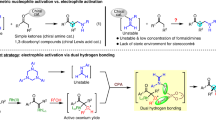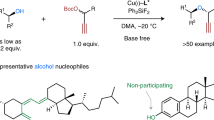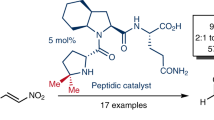Abstract
Ina note under this title, Gerrard and Nechvatal1 have reported the conversion of neopentyl alcohol, (CH3)3C.CH2.OH (here written ROH), by thionyl and phosphorus halides into the esters RO.SOCl and RO.PCl2, inter alia. They remark that Whitmore and Rothrock2 demonstrated the resistance of neopentyl alcohol to the replacement of its hydroxyl group by halogen, through the agency of thionyl chloride and phosphorus tribromide. They add that we3 have attributed this to the steric hindrance of what they call “end-on approach” to the α-carbon atom. They state that Whitmore and Rothrock leave the impression that neopentyl alcohol does not react at all with the halides specified; but that the work of Gerrard enabled Gerrard and Nechvatal to predict the probability of an easy “broadside approach” of the reagents. We should like to add some points to this statement of the relation between the different investigations.
This is a preview of subscription content, access via your institution
Access options
Subscribe to this journal
Receive 51 print issues and online access
$199.00 per year
only $3.90 per issue
Buy this article
- Purchase on Springer Link
- Instant access to full article PDF
Prices may be subject to local taxes which are calculated during checkout
Similar content being viewed by others
References
Nature, 159, 812 (1947).
J. Amer. Chem. Soc., 54, 3431 (1932).
J. Chem. Soc., 173 (1946).
J. Chem. Soc., 1252 (1937).
Author information
Authors and Affiliations
Rights and permissions
About this article
Cite this article
DOSTROVSKY, I., HUGHES, E. & INGOLD, C. neoPentyl Alcohol and Steric Hindrance. Nature 160, 901–902 (1947). https://doi.org/10.1038/160901b0
Issue Date:
DOI: https://doi.org/10.1038/160901b0
Comments
By submitting a comment you agree to abide by our Terms and Community Guidelines. If you find something abusive or that does not comply with our terms or guidelines please flag it as inappropriate.



